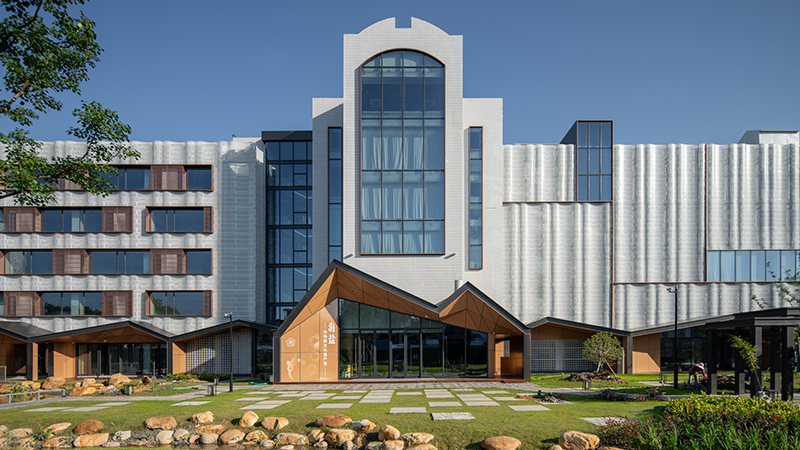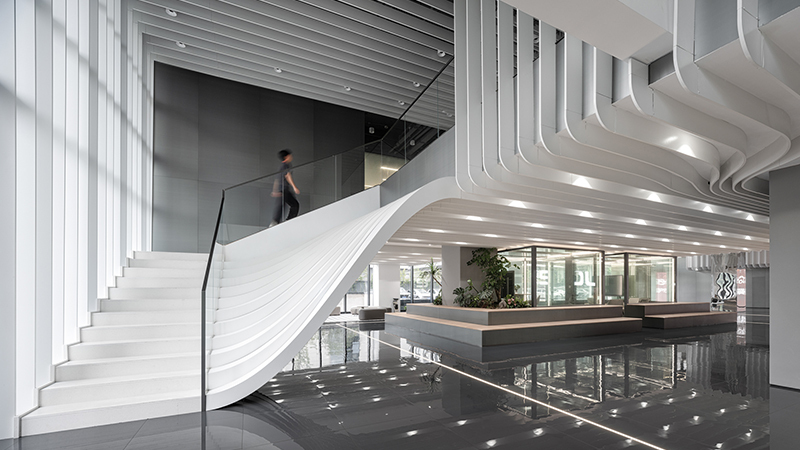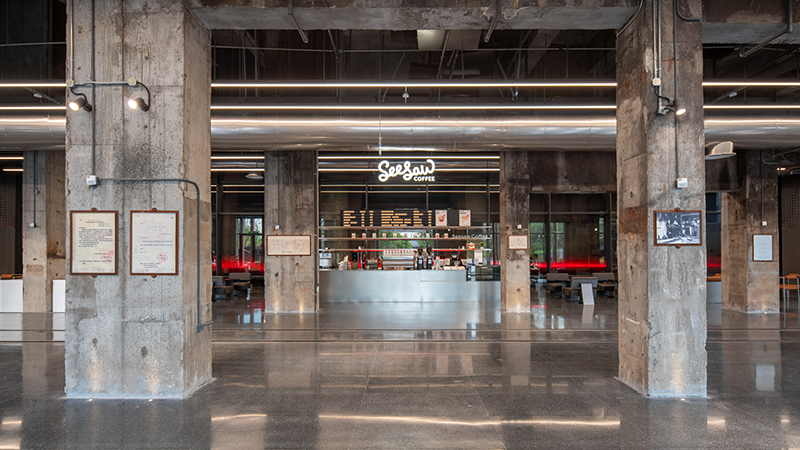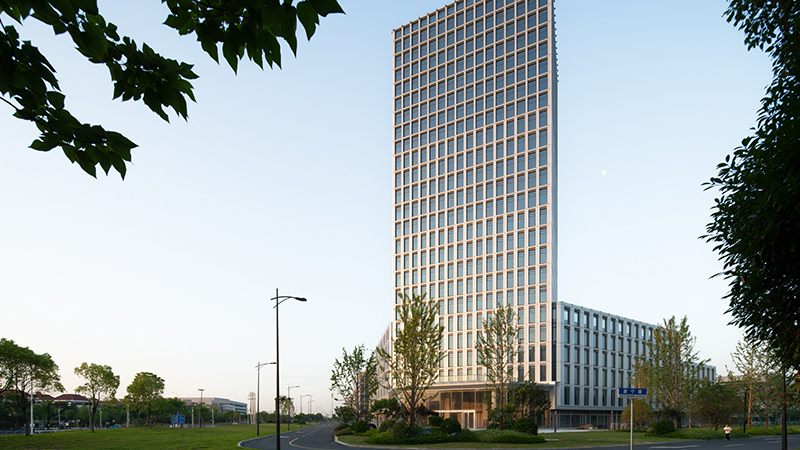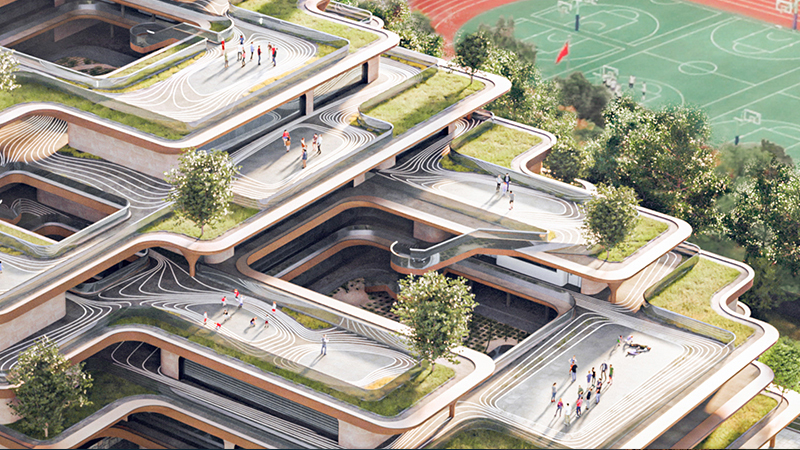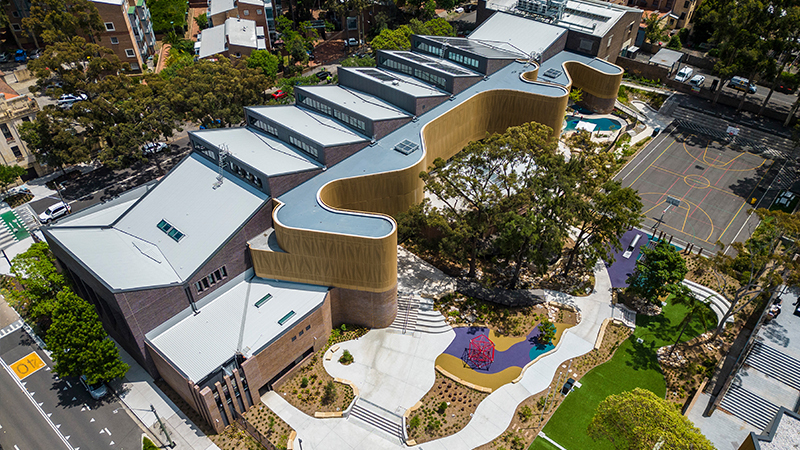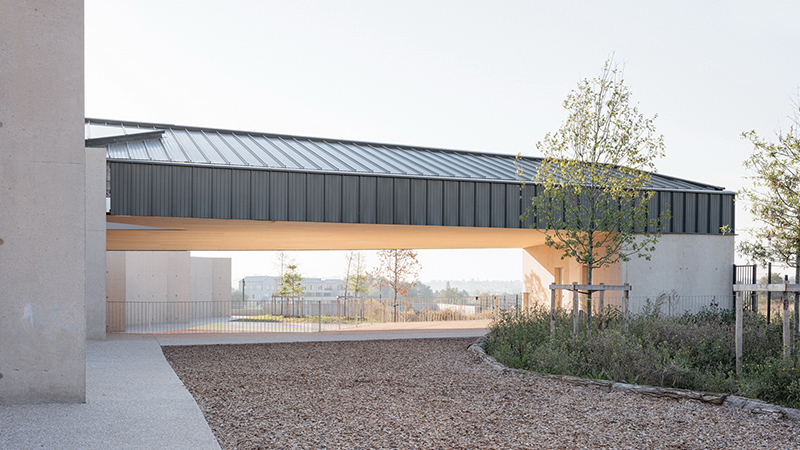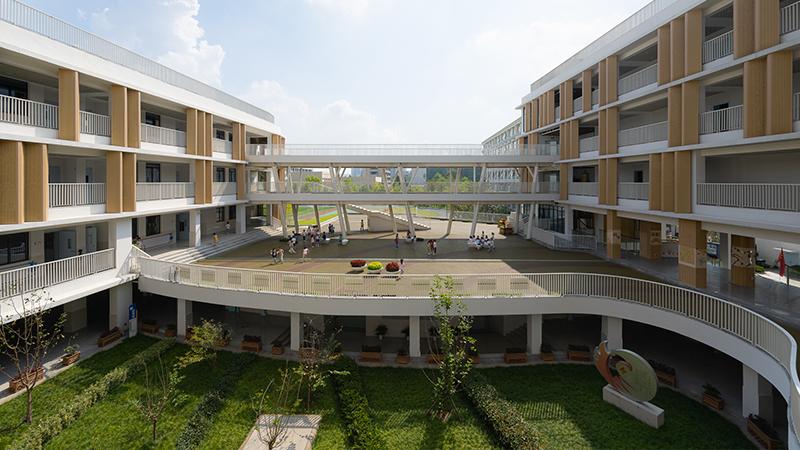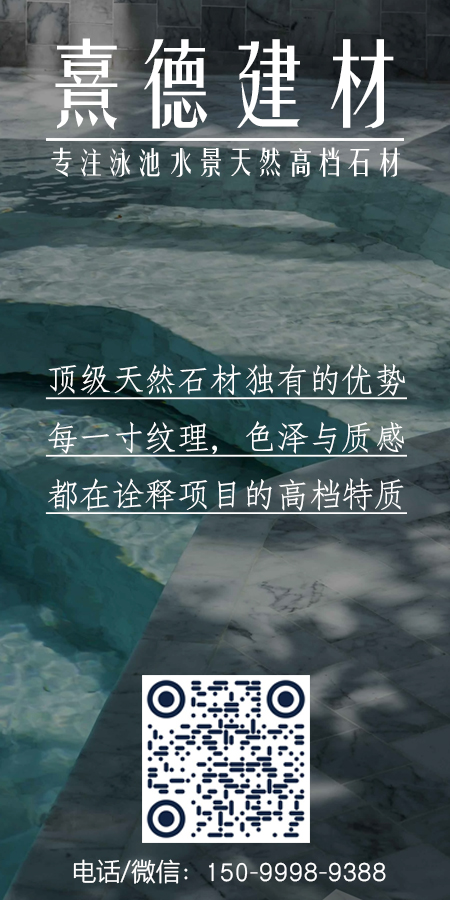衢州第六实验学校由零壹城市建筑事务所(LYCS Architecture)担纲建筑设计。项目位于衢州市高铁新城常山路,总建筑面积约67,500平方米,是一座涵盖36 班小学和18 班中学的综合性校园。
The Quzhou No.6 Experimental School is designed by LYCS Architecture. Located on Changshan Road in Quzhou’s High-Speed Rail New Town, the campus spans approximately 67,500 square meters. It is a comprehensive educational complex accommodating a 36-class primary school and an 18-class middle school.
传统校园通常由广场、院落和道路构成,彼此边界分明。然而,随着教育理念的革新,教学模式正从教师单向传授转变为学生自主学习,单一的教室空间已无法满足当代教育对于多样化学习环境的需求。本项目的核心设计目标,便是营造一个开放自由的校园环境,以促进学生的观察、探索和交流,打造富有活力的学习场所。
Traditional school campuses are often composed of plazas, courtyards, and roads with clearly defined boundaries. However, as educational philosophies evolve, teaching models shift from teacher-centered instruction to student-driven learning. A single classroom can no longer accommodate the diverse spatial needs of contemporary education. The core design goal of this project is to create an open and flexible campus environment that encourages observation, exploration, and communication among students—ultimately fostering a vibrant atmosphere for learning.
发散的“成长之树”The Diverging Tree of Growth
设计从传统教学空间中抽离创意性公共空间,以”成长之树“为概念,将教学空间、复合空间与创新空间分别比作 树根、树干与树冠(花、枝、叶),并沿着西至东的方向布置,形成校园的整体规划体系。
The design departs from conventional educational spaces by introducing creative public areas guided by the concept of a “Tree of Growth.” In this metaphorical framework, teaching spaces represent the roots, hybrid spaces form the trunk, and innovation spaces correspond to the canopy—comprising flowers, branches, and leaves. These elements are organized along a west-to-east axis, shaping the overall spatial structure of the campus.
此外,校园内分布着不同尺度的公共与半公共空间,如教室门口的口袋公园、走道尽头的山墙面,以及校园中心的大型文体活动聚落,分别对应课间、课中、课后的不同活动需求。这些空间通过街道与连廊串联,使传统教学空间获得新的功能赋能,转化为面向未来的创新自主学习场所。
In addition, the campus features a variety of public and semi-public spaces in different scales—pocket parks at classroom entrances, gable-end alcoves at the end of corridors, and a central cluster of large-scale venues for cultural and sports activities. These spaces respond to different rhythms of school life, from in-between class breaks to during-class interactions and after-class gatherings.Connected by streets and corridors, they enrich the traditional teaching spaces with new functions, transforming them into future-oriented environments that support innovation and self-directed learning.
在“街头巷尾”邂逅Unexpected Encounters Along the Campus Streets
在传统教学空间、复合空间与创新空间之间,设计创新性地引入“街道”概念,以蜿蜒曲折的主街与穿越高差的支路,串联起各个校园功能区域,构建多元复合的校园空间体系,激发丰富的校园生活体验。
The design introduces the concept of a “street” as an organizing element between the traditional teaching spaces, hybrid spaces, and innovation spaces. A meandering main street and secondary paths that navigate level changes weave through the campus and connect its functional zones. This spatial system fosters a rich and diverse campus experience, encouraging interaction, movement, and a sense of discovery throughout daily school life.
自南向北,校园中轴线上的一条曲折主街将整个校园联结起来,沿途步移景异,绿意盎然的地景公共空间、教学楼趣味十足的山墙面与庭院空间依次展开。这条街道不仅链接了教育教学、艺术人文、聚集活动三个核心区域,更为学生提供了在 “街头巷尾” 观察、探索、邂逅与交流的机会。
Running from south to north, a winding main street forms the central axis of the campus, stitching together the entire site. As one moves along the route, the scenery shifts continuously—lush landscaped public spaces, playful gable-end façades, and layered courtyard environments unfold one after another. More than just a circulation path, this street connects the three core zones of the campus: education, arts and humanities, and communal gathering. It also offers students opportunities to observe, explore, encounter, and connect—along the familiar paths and everyday corners of campus life.
从西向东,数条支路串联起半围合的院落、下沉庭院和空中连廊,并连接至校园的文体活动中心,营造出起伏变化的空间体验。这些路径在引导动线的同时,也形成了多个尺度各异、层次丰富的交汇节点。
Extending from west to east, a series of secondary paths connect various spatial elements—semi-enclosed courtyards, sunken gardens, and elevated walkways—leading toward the campus’s cultural and athletic center. These routes not only guide circulation, but also create layered intersections at varying scales throughout the journey.
教室门口的“口袋公园”Mini pocket gardens at the classroom threshold
校园主街一侧的教学区由两座“E”形教学组团 组成,建筑山墙面形成具有 “厚度” 的端头空间,在其中巧妙置入直跑楼梯、双跑楼梯,连接休息平台与缓冲空间,同时在顶层形成开放露台,在底层打造架空入口。通过虚实对比、色彩运用与形态变化,强化端头空间的可识别性,使其成为街道界面的重要标志。
On one side of the main campus street, the teaching area comprises two “E”-shaped academic clusters. The gable-end façades of these buildings are designed as spatially “thickened” terminal volumes, ingeniously integrating single-flight and double-flight staircases that connect rest platforms and transitional spaces. At the top, these volumes open up into rooftop terraces; at the base, they form sheltered, open-air entrances. Through contrasts of solid and void, the use of color, and variations in form, the design enhances the visibility and identity of these terminal spaces—establishing them as key markers along the campus street.
此外,“空中口袋公园”作为街道在教学空间中的延伸,以多样主题、形态和色彩的非正式学习空间散落在教学楼之间。这些空间不仅激发了交流与探索,也为教学楼之间的日常流动注入了更多活力与趣味。
In addition, “sky pocket parks” extend the idea of the campus street into the upper levels of the teaching blocks. Scattered between buildings, these informal learning spaces vary in theme, form, and color. They foster interaction and exploration while bringing vibrancy and playfulness to the everyday circulation between blocks.
教学区形成了“端头空间—走廊—空中口袋公园”的富有韵律的空间序列,这些空间通过楼层错动和功能配置,构建多层次的灰空间,使学生在日常行走间即可进行交流讨论、宣讲演出或实践活动。
The teaching area forms a rhythmic spatial sequence of “terminal space – corridor – sky pocket park,” embedding opportunities for interaction and learning throughout the campus experience.Through staggered floor plates and strategic program placement, they create a multi-layered system of semi-open “grey spaces,” where students can spontaneously engage in conversation, discussion, performances, or hands-on activities as part of their daily movement through the campus.
恣意的“文体聚落”A Playful Cluster of Culture and Sports
校园主街的另一侧被打造为“文体活动中心”,建筑由四个大小不一、形态各异、富有趣味的体量组成,分散布局在景观坡地之上,为孩子们创造自由穿梭、互动交流的活动场所。
On the opposite side of the campus’s main street lies the Cultural and Sports Center—a collection of four volumes, each varying in size, shape, and character. Playfully scattered across a landscaped slope, these buildings offer children a dynamic environment where they can move freely, interact with one another, and engage in a wide range of activities.
地景设计既解决了场地的竖向高差问题,又承载了丰富的文体活动功能。起伏的地形使教学区与运动场有机衔接,塑造出一个极具活力的校园乐园。它不仅拓展了学生的活动边界,也激发了更多户外交流的可能。
The landscape design resolves the site’s vertical elevation changes and integrates a wide range of cultural and athletic functions. The undulating terrain creates a seamless transition between the teaching area and the sports field, shaping a vibrant and playful campus landscape for students to explore and enjoy. It expands the boundaries of student activity and encourages more spontaneous outdoor interaction.
“大台阶”空间作为运动场与文体中心的过渡区域,满足学生日常通行、升旗仪式等功能,同时也因坡地景观的点缀,成为适合合唱表演、读书分享、锻炼打卡等活动的理想场所。
The “Grand Steps” is a transitional zone between the sports field and the Cultural and Sports Center, accommodating daily circulation, flag-raising ceremonies, and other routine functions. Enriched by the surrounding sloped landscape, this area also becomes an ideal setting for choral performances, reading sessions, casual workouts, and various spontaneous student activities.
结语Conclusion
在多元化教育趋势下,对“学习”方式的认知正在发生转变,校园设计也正从单一教学空间走向复合型学习场所。衢州第六实验学校的设计创新性地引入 “校园街道” 概念,使其成为连接 多层次活动空间与非正式教学场所 的纽带,创造一个充满 探索、交流与成长 可能性的校园环境。
As education embraces greater diversity, the way we understand learning continues to evolve—and so does the architecture that supports it. At Quzhou No.6 Experimental School, introducing the “campus street” reimagines how students move, connect, and engage within a learning environment. By linking formal and informal spaces, structured programs, and spontaneous moments, the design creates a vibrant setting where exploration, communication, and growth can take root every day.
在校园的街道邂逅 | 衢州市第六实验学校
地点:中国,衢州
业主:衢州市西区投资有限公司
面积:67,500 平方米
详细地址:衢州市柯城区常山路 199 号
设计时间:2021年4月—2023年3月
建造时间:2023年3月—2024年8月
建筑设计:零壹城市建筑事务所
设计团队:阮昊、詹远;于志强、赵霖、袁嘉妮、段琴、袁丛远、汤朱秒,章敬一、杭高峰、周飞霞、殷悦,沈成龙,陈庆舜,阮子明
景观设计:上海广亩景观设计有限公司
配合设计院:浙江天然建筑设计有限公司
施工方:中国机械工业建设集团有限公司
摄影:山间影像
Encounter on a Campus Street | Quzhou No.6 Experimental School
Location: Quzhou | China
Client: Quzhou West District Investment Co., Ltd
Area: 67,500 ㎡
Address: No. 199 Changshan Road, Kecheng District, Quzhou City
Design Date: 2021/04—2023/03
Construction Date: 2023/03—2024/08
Architecture Design: LYCS Architecture
Design Team: RUAN Hao, ZHAN Yuan; YU Zhiqiang, ZHAO Lin, YUAN Jiani, DUAN Qin, YUAN Congyuan, TANG Zhumiao, ZHANG Jingyi, HANG Gaofeng, ZHOU Feixia, YIN Yue, SHEN Chenglong, CHEN Qingshun, RUAN Ziming
Landscape Design: GM LANDSCAPE DESIGN
Cooperative Design Institute: Tianran Design Group
Contractor: China Machinery Industry Construction Group Inc.
Photography: Shan-Jian Images
更新日期:2025-04-16 16:08:32
非常感谢 零壹城市建筑事务所 带来的精彩项目, 查阅更多Appreciations towards LYCS Architecture for sharing wonderful work on hhlloo. Click to see more works!






























